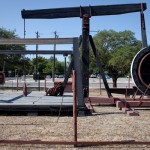Orphans of the Oil Fields: The Cost of Abandoned Wells

Texaco Inc. Photograph Collection, Courtesy Sam Houston Regional Library, Liberty, TX
The early days of drilling in East Texas but does anyone know where all the wells are now?
Scattered across the oil and gas fields of Texas where fortunes have been won and sometimes lost, there are at least 7,869 abandoned wells. The Texas Railroad Commission (RRC) which regulates drilling calls them orphans.
By the RRC’s count, there are an additional 5,445 wells that are inactive and whose operators are delinquent in meeting regulations. Add to all that an unknown number of orphan wells drilled decades ago for which records have been lost, if they ever existed.
You can find some of the orphans in the South Liberty Oil field in Liberty County. It’s just 45 miles east of Spindletop, the iconic oil field in Beaumont that a century ago was the most productive in the world.
That was a different era.
“I can assure you that back (then), the environment was not part of the equation,” said Stuart Marcus.
As a manager of the Trinity River National Wildlife Refuge, Marcus is intimately familiar with this part of East Texas. As he drove the backroads just south of the town of Liberty, there are pump jacks that bob up and down bringing up the oil. Some are mere feet from homes, others are in forests surrounded by trees and vegetation.
“Back in the day, this was an active oil field site. And as you can see, there are a lot of pumpjacks still in operation. But they’re low-flow. They don’t produce a lot of oil at this time,” said Marcus.
Less obvious and harder to find are wells that no longer produce at all and were abandoned by their operators. An easier way to find them is using the RRC’s Orphan Wells data base.
Among dozens of different orphan wells and the companies that once operated them, one that pops up multiple times in the RRC data base for Liberty County is an operator with a memorable name: the Good Ol’ Boys Oil Company.
After failing to get the company to plug some of the old wells, the RRC said it has now barred the company from doing oil and gas operations in Texas. In an “enforcement action” document filed in March of 2000, the RRC alleged that five wells “have not been properly plugged” and that “usable quality water in the area is likely to be contaminated by migrations or discharges of saltwater and other oil and gas wastes…”
In 2001, the Texas Attorney General won a default judgement against the Good Ol’ Boys Oil Company for $216,845 plus court costs and fees, according to a spokesperson.
“The account was considered uncollected and closed as there were no corporate assets available to pursue. Comptroller records indicate the corporate charter was dissolved in 2005,” wrote Tom Kelley with the Attorney General’s Press Office in an email to StateImpact.
There have been thousands of wells over the years that have cost the State of Texas millions to clean up and plug. Since 1984, Texas has spent over $247 million “using the Oil Field Cleanup Fund and other state and federal sources of funds” according to an RRC report. (Update: Railroad Commission spokesperson Ramona Nye emailed StateImpact Texas to say that “the plugging of orphan wells and cleanup of abandoned sites is primarily funded by fees collected from the industry and deposited in the Oil & Gas Regulation Cleanup Fund, formerly the Oilfield Cleanup Fund. Texas taxpayers do not pay into this fund.”)
Now, as oil and gas drilling booms in the very same regions of North and South Texas where state records also show the highest number of orphaned wells, it begs the questions: will history repeat itself, will there be a new generation of orphan wells when this current boom subsides?
Not likely according to Scott Tinker with the University of Texas Bureau of Economic Geology. Tinker sits on the state’s Oilfield Cleanup Fund Advisory Committee.
“There’s stronger oversight. The permits are there and there’s insurance and bonds that are required,” Tinker told StateImpact.
He’s talking about new regulations passed by Texas lawmakers in 2004. They require that operators have insurance to cover the cost of plugging a well. That has “helped ensure that operators don’t abandon wells at high levels seen before financial assurance was required on a well” wrote RRC spokesperson Ramona Nye in an email to StateImpact.
“Most wells in Texas are plugged by operators of record and not abandoned. Of those wells that are orphaned, this population is dropping,” wrote Nye, citing RRC records showing the total number of orphan wells is now half what it was in 2003.






